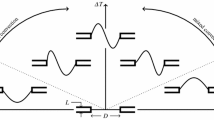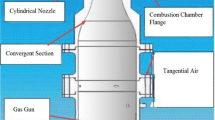Abstract
An experimental study investigates the natural convection flow through a horizontal ceiling vent of a fire compartment. This flow is governed by the buoyancy forces and the friction forces, and is bidirectional. The orifice used is of circular cross section and is characterized by the aspect ratio L/D of its thickness L over its diameter D. The reduced scale apparatus consist of two superimposed compartments of \(1.5 \times 1 \times 1 \, \mathrm{m}^3\) for the lower and \(1 \times 1 \times 1 \, \mathrm{m}^3\) for the upper. These two rooms are connected by a 0.038 m length circular orifice with different diameters available (\( D \in [63.5, \, 76.2, \, 127, \, 152.4, \, 190.5, \, 260\) mm]). For the study of natural convection, only the lower compartment is used; the upper compartment is left at atmospheric conditions by removing all its walls. The temperature gradient (\(\Delta T \approx 50^\circ \)C between the bottom and the top of the orifice) is generated by a 2 kW electrical resistor located in the lower compartment. This electrical resistor makes it possible to generate, without mass inlet, a plume with no soot and to reach a thermal steady state in the “fire room”. The optical stereoscopic particle image velocimetry measurement technique provides the velocity field through the opening for different diameters. This technique, based on the finding of the displacement of a set of particles between two consecutive snapshots of a seeded fluid, makes it possible to obtain all three components of the velocity vector field by non-intrusive measurement. The use of this technique is a novelty for such vent flows and allows accessing information not only on the variation of the flow rate but also on the distribution of the fluids moving upward and downward through the orifice. Despite an unsteady dynamic regime, the analysis of averaged fields shows a geometrical organization of the bidirectional flow through the orifice, with a central area occupied by the hot fluid flowing upward and a peripheral zone where the cold fluid flows downward. The flow section occupancy ratio reverses with the extrema of flow velocities, for \(L/D \approx 0.41\).












Similar content being viewed by others
References
Lieberman P, Bell D (1973) Smoke and fire propagation in compartment spaces. Fire Technol 5:91–100
Pretrel H, Koched A, Audouin L (2015) Doorway flows induced by the combined effects of natural and forced ventilation in case of multi-compartments large-scale fire experiments. Fire Technol. doi:10.1007/10.1007/s10694-015-0524-8
Chen X, Lu S, Wang X, Liew KM, Li C, Zhang J (2015) Pulsation behavior of pool fires in a confined compartment with a horizontal opening. Fire Technol. doi:10.1007/s10694-015-0484-z
Brown WG (1962) Natural convection through rectangular openings in partition—horizontal partitions. Int J Heat Mass Transf 5:869–878
Mercer A, Thompson H (1975) An experimental investigation of some further aspects of the buoyancy driven exchange flow between carbon dioxide and air following a depressurization accident in a magnox reactor, Part I: the exchange flow in inclined ducts & Part II: the purging flow requirements in inclined ducts. J Br Nucl Energy Soc 14:327–340
Epstein M (1988) Buoyancy driven exchange flow through small openings in horizontal partitions. J Heat Transf 110:885–893
Conover TA, Kumar R, Kapat JS (1995) Buoyant pulsating exchange flow through a vent. J Heat Transf 117:641–648
Gera B, Sharma PK, Singh RK (2012) Effect of the opening aspect ratio on a buoyant pulsating exchange flow through a circular ceiling opening in a horizontal partition. Heat Transf Asian Res
Tan Q, Jaluria Y (1992) Flow through horizontal vents as related to compartment fire environments. National Institute of Standards and Technology, Gaithersburg. (NIST-GCR-92-607)
Li Z (2007) Characteristics of buoyancy driven natural ventilation through horizontal openings. PhD Thesis, Aalborg University
Bryant RA (2009) The application fo stereoscopic PIV to measure the flow of air into an enclosure containing a fire. Exp Fluids 47:295–308
Koched A, Pretrel H, Vauquelin O, Audouin L (2013) Experimental determination of the discharge coefficient of a doorway using the spiv technique for fire-induced flow applications. International Conference on Fire Research and Engineering (Interflam)
Raffel M, Willert C, Wereley S, Kompenhans J (2007) Particle image velocimetry, a practical guide, 2nd edn. New York, Springer
Author information
Authors and Affiliations
Corresponding author
Rights and permissions
About this article
Cite this article
Varrall, K., Pretrel, H., Vaux, S. et al. Stereoscopic Particle Image Velocimetry Investigation of the Bidirectional Natural Convection Flow Through a Horizontal Vent. Fire Technol 52, 2027–2041 (2016). https://doi.org/10.1007/s10694-016-0593-3
Received:
Accepted:
Published:
Issue Date:
DOI: https://doi.org/10.1007/s10694-016-0593-3




